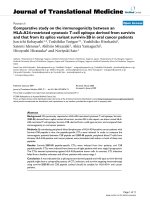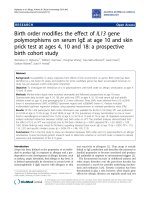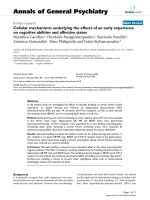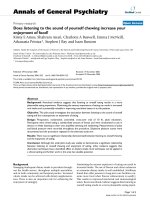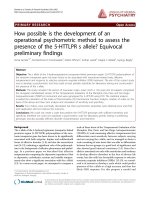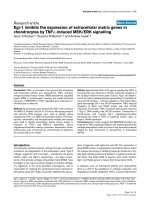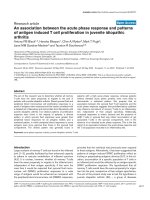Báo cáo y học: "Comparative study between the Hybrid Capture II test and PCR based assay for the detection of human papillomavirus DNA in oral submucous fibrosis and oral squamous cell carcinoma" pdf
Bạn đang xem bản rút gọn của tài liệu. Xem và tải ngay bản đầy đủ của tài liệu tại đây (3.44 MB, 10 trang )
RESEARC H Open Access
Comparative study between the Hybrid Capture II
test and PCR based assay for the detection of
human papillomavirus DNA in oral submucous
fibrosis and oral squamous cell carcinoma
Ajay Kumar Chaudhary
1,2*
, Shruti Pandya
2
, Ravi Mehrotra
2
, Alok C Bharti
4
, Mangal Singh
3
, Mamta Singh
2*
Abstract
Background: Oral malignancy is a major global health problem. Besides the main risk factors of tobacco, smoking
and alcohol, infection by human papillomavirus (HPV) and genetic alterations are likely to play an important role in
these lesions. The purpose of this study was to compare the efficacy of HC-II assay and PCR for the detection of
specific HPV type (HPV 16 E6) in OSMF and OSCC cases as well as find out the prevalence of the high risk HPV
(HR-HPV) in these lesions.
Methods and materials: Four hundred and thirty patients of the potentially malignant and malignant oral lesions
were taken from the Department of Otorhinolaryngology, Moti Lal Nehru Medical College, Allahabad, India from
Sept 2007-March 2010. Of which 208 cases were oral submucous fibrosis (OSMF) and 222 cases were oral
squamous cell carcinoma (OSCC). The HC-II assay and PCR were used for the detection of HR-HPV DNA.
Result: The overall prevalence of HR-HPV 16 E6 DNA positivity was nearly 26% by PCR and 27.4% by the HC-II
assay in case of potentially malignant disorder of the oral lesions such as OSMF. However, in case of malignant oral
lesions such as OSCC, 32.4% HPV 16 E6 positive by PCR and 31.4% by the HC-II assay. In case of OSMF, the two
test gave concordant result for 42 positive samples and 154 negative samples, with an overall level of agreement
of 85.4% (Cohen’s kappa = 66.83%, 95% CI 0.553-0.783). The sensitivity and specificity of the test were 73.7% and
92.05% (p < 0.00). In case of OSCC, the two test gave concordant result for 61 positive samples and 152 negative
samples, with an overall level of agreement of 88.3% (Cohen’s kappa = 79.29, 95% CI 0.769-0.939) and the
sensitivity and specificity of the test were 87.14% and 92.76% (p < 0.00).
Conclusion: This study concluded that slight difference was found between the positivity rate of HR-HPV infection
detected by the HC-II and PCR assay in OSMF and OSCC cases and the HC II assay seemed to have better
sensitivity in case of OSCC.
Background
Oral malignancy is a major global health problem and it
constitutes the sixth most common malignancy. More
than 90% of these malignancies representing a squamous
cell carcinoma (SCC), which are often preceded by pre-
existing oral lesions termed as potential ly malignant
disorders of the oral mucosa such as oral sub mucous
fibrosis (OSMF) [1]. OSMF occurs most commonly in
South East Asia, but many cases, it has been reported
worldwide, in countries like China, UK, Kenya, Saudi
Arabia, Pakistan and other parts of the world [2]. In
India, about 5 millions people suffer from this disease [3].
Mehrotra et al reported that potentially malignant and
malignant disorders of the oral mucosa were widespread
in the patients visiting in the Medical College and SRN
hospital, Allahabad a nd suggested that OSMF consti-
tuted the highest number of the patients in the poten-
tially malign ant group while in case of malign ant group,
* Correspondence: ;
1
Centre for Biotechnology, University of Allahabad, India
2
Department of Pathology, Moti Lal Nehru Medical College, Allahabad, India
Full list of author information is available at the end of the article
Chaudhary et al. Virology Journal 2010, 7:253
/>© 2010 Chaudhary et al; licensee BioMed Central Ltd. This is an Open Access article distributed under the terms of the Creative
Commons Attribution License (http://creativecommons. org/licenses/by/2.0), which permits unrestricted use, distribution, and
reproduction in any medium, provided the original work is properly cited.
OSCC was most prevalent in this region [4]. The habits
of chewing tobacco and areca nut with or witho ut betal
quid are rampant in this area. Besides the main risk fac-
tors of tobacco, smoking and alcohol, infection by
human papillomavirus (HPV) and genetic alterations are
likely to play an important role in these lesio ns [5].
Oncoge nic HPVs are a main causative agent for cervical
cancer, but the role of HPV infection in OSMF and
OSCC is less established.
Human papillomavirus is about 55 nm in diameter. It
has a single circular double stranded DNA molecule and
belongs to the family papillomaviridae. Its genome is
made up of 7,200-8,000 base pairs with a molecular
weight of 5.2 × 10
6
D. Molecular evidences also provide
support to the role of high risk HPV, particul arly HPV-
16, in the pathogenesis of OSCC of the head and neck
[6]. Kreimer et al reported that genomic DNA of onco-
genic HPV has been detected approximately 26% of all
OSCC of the head and neck worldwide [7] but the most
accurate and consistent study for OSMF and OSCC, in
which viral inte gration and the expression of viral onco-
genes (E6 and E7) have been shown [8].
HPV detection in potentially malignant and malignant
oral squamous cell carcinoma showed many discrepan-
cies. Several studies reported the presence of HPV-DNA
within these lesions with variable frequency. HPV16 and
18 genotypes were the most frequently found viruses in
these lesions. Bouda et al suggested that high risk HPV
E6/E7 transcripts and viral integration have also been
detected in head and neck squamous cell carcinoma
(HNSCC). Transcriptionally active HR-HPVs, particu-
larly HPV-16 are found in a subset of HNSCC. HPV16-
associate d carcinogenesis is mediated by expression of
the viral E6 and E7 oncoproteins, which cause deregula-
tion of the cell cycle by inactivating p53 and pRb
respectively [9]. Integration often disrupts the integrity
and expression of the E1 and E2 open reading frames,
which may af fect the transcription of E6 and E7 genes
[10-13]. In HPV-16 and HPV-18, the E 2 proteins are
active in virus proliferation, it control E6-E7 gene
expression and are necessary for episomal virus produc-
tion [10]. Specific viral genes (E6 and E7) from HPV
types 16, 18, and 33 act as oncogenes [14,15].
Recentaly, a second-generation assay with improved
diagnostic sensitivity has been developed known as
hybrid capture II test (HC-II) and approved by the US
food and drug administration (F DA). The performance
characteristics of HC-II assay and the PCR for detection
of HPV DNA have been compared in cervical lesions
and results shown variation. [16-19]. Many testing tech-
niques used to identify the prevalence rate of cervi cal as
well as oral associated HPV infection have been devel-
oped but specific HPV testing may not be proper as a
primary screening tool due to lack of specificity and
sensitivity of the test. Newly developed molecular tech-
niques have significantly assisted to indentifying the
association of HR-HPV types with these oral lesions.
The purpose of this study was to compare the efficacy
of HC-II assay and PCR for the detection of specific
HPV type (HPV 16 E6) in OSMF and OSCC cases as
well as find out the prevalence rate of the HR-HPV in
these lesions.
Materials and methods
Clinical data collection and sample collection
Four hundred and thirty patients of the OSMF and
OSCC cases were taken from the Departme nt of Pathol-
ogy & Department of Otorhinolaryngology, Moti Lal
Nehru Medical College, Allahabad, India from Sept
2007-March 2010, in a random manner after obtaining
consent from the institutional ethical committee. Of
which 208 cases were OSMF and 222 cases were OSCC.
Detailed demographic information of each patient,
including the patient’ s age, sex, addiction habits was
obtained. Emphasis was given on their addiction habits.
Usually those pa tients were consid ered who had no pre-
vious history of treatment for HPV infection. Figure 1
illustrating the oral sample collection and HPV testing
strategy [Figure 1].
Detailed clinical examination of each patien t was done
to assess the site, siz e and type of lesions. For confirma-
tion of the clinical diagnosis, histopathological examina-
tion was carried o ut. Patients wi th OSMF were included
in this study and lesions with an abnormal epithelial
surface like erythroplakia, leukoplakia and submucosal
lesions including hemangiomas, mucoceles, papilloma,
aphthous ulcers, melanoplakia and fibromas were
excluded due to less number. A punch biopsy was per-
formed as per standard protocol and the tissu e was pro-
cessed by paraffin embedding 2-3 micrometer thick
sections were cut and stained by haematoxylin and
eosin (H and E). Biopsies, which were inadequate on
histopathology, were excluded from the study.
Histopathological examination was done and results
were recorded according to the traditional gra ding of
OSMF by Pindborg and Sirsat [20]. A ll specimens were
examined independently by 2 different histopathologi sts
in a double blind fashion. If there were any discrepan-
cies, a third opinion was obtained. Two similar opinions
constituted the final diagnosis.
Samples were collected from the suspicious lesions of
theoralcavitybyasoftbrushprovidedinthekit.Gen-
tle rolling strokes were made over the affected area as
per the manufacturer’ s instructions and samples were
collected in the sample collection tubes, stored at 4°C
till the HC-II test was performed and also b iopsies of
the same site were taken in 1 × phosphate buffer saline
(PBS) solution for the isolation of HPV-DNA.
Chaudhary et al. Virology Journal 2010, 7:253
/>Page 2 of 10
Detection of 13 type high-risk HPV (HR-HPV) by hybrid
capture-II (HC-II) assay
Second-generation commercial HR-HPV test, the HC II
assay *Digene® (manufacturer), a FDA approved test for
clinical diagnostics was utilized. Detection o f HPV DNA
was carried out in the presence of a probe which consist
the 13 high risk HPV (HR-HPV) types (16, 18, 31, 33, 35,
39, 45, 51, 52, 56, 58, 59 and 68). This technique is a
nucleic acid hybridizat ion assay with signal amplification
that utilizes micro-plate chemiluminiscent detection.
Procedure of the HC-II test
First, double stranded DNA was denatured by using a
strong alkaline den aturation solution and converted into
single stranded DNA ( ssDNA). This ssDNA was then
hybridized in-solution to a cocktail of specific 13 HR-
HPV RNA prob es. The resultant DNA-RNA hybrids are
captured onto the surface of a microwell plate coated
with specific antibodies for DNA-RNA hybrids. The
immobilized hybrids are then reacted with alkaline
phosphatase conjugated antibody and detected by
Figure 1 Fi gure 1 illustrated the oral sub mucous fibrosis (OSMF) and oral squamous cell carcinoma (OSCC) specimen collection and
HPV DNA testing methods.
Chaudhary et al. Virology Journal 2010, 7:253
/>Page 3 of 10
cleavage of the chemiluminescent substrate. The emitted
light was measured as relative light unit (RLU) in a
luminometer (DML 2000, Digene®). The inten sity of the
light was proportional to the amount of target DNA in
the sample.
Estimation of HPV viral load
Ratio of relative light unit (RLU) of the sample/mean of
RLU of three positive controls (PC) were taken as an
estimate of approximate viral load which relates to the
index of the intensity of HPV infection. This ratio of
any specimen represents empirically a relative measure
of the viral load in it. Cut off val ue (RLU of specimen/
mean RLU of PC) was 1.0 pg/ml of sample.
Interpretation of Cut off value (RLU of specimen/mean RLU
of PC)
Cut-off ratio of 0 t o 0.99 is negative for HR HPV; Cut -
off ratio greater than 1.0 positive for HR HPV. The cut
off ratio at 1.0 correspond to viral DNA load of 5,000
copies/ml of 1pg/ml at a threshold of finding a clinical
disease or prognosis of an OSMF and OSCC lesions.
DNA extraction and diagnosis of high risk HPV infection
by polymerase chain reaction
High molecular weight genomic DNA was extracted from
oral biopsies of patients by using the Qiagen QIAamp
DNA tissue Kit (Qiagen Inc. USA) The extracted geno-
mic DNA was quantified and checked for purity spectro-
photometrically (Spectro UV-Vis Double Beam PC, UVD
Model2950LABOMED,Inc.CA,USA)Ethidiumbro-
mide (EtBr) stained 0.8% agrose gel electrophoresis was
used to confirm presence of DNA in samples.
Detection of HPV DNA
PCR amplification w as performed using the consensus
degenerate primers (L1 gene) [MY09: 5’ -GCM CAG
GGW CAT AAY AAT GG-3’, MY11:5’-CGT CCM ARR
GGA WAC TGA TC-3’ where M = A/C; W = A/T; Y =
C/T; R = A/G) with an amplicon size 450 bp, as
described earlier [21]. Further typing of high risk HPV
types 16 E6 was done by type-specific forward primer
(FP) 5’ -GAA ACC GGT TAG TAG TAT AAA AGC
AGA C-3’ and reverse primer (RP) 5’-AGC TGG GTT
TCT CTA CGT GTT CT-3’ with an amplicon size 506
bp [Figure 2]. b-globin gene primer was used as internal
control, FP 5’-GAA GAG CCA AGG ACA GGT AC-3’
and RP 5’ -CAA CTT CAT CCA CGT TAC ACC-3’ ,
with an amplicon size 268 bp. HPLC purified primers
were custom-synthesized by Metabion GmbH, Germany.
PCR was performed in a 25 μL reaction mixture con-
taining 50-100 ng DNA, 10 mM Tris-HCl (pH 8.4), 50
mM KCl, 1.5 mM MgCl
2
,100μM of each dNTPs
(dATP, dGTP, dCTP, dTTP) (Fermentas Inc.USA), 10
pmoles of oligonucleotide primers and 0.5U Taq DNA
polymerase (Banglore Genei Pvt.Ltd.,India). The thermal
cycler (PTC-100 MJ research GMI, Inc, Minnesota,
USA) used, where an initial denaturation at 94°C for
5 min followed by 34 cycles of denaturation at 94°C
for 30 s, annealing at 55°C for 30 s and extension at 72°
C for 1 min, which was extended for 5 min at the final
cycle.
Statistical analysis
Level of agreement was calculated by both absolute
agreement and Cohen’s kappa statistic (k), a measure of
the agreement between two methods in excess of that
duetochance[22].Proportions were compared with
exact p values for the Pearson chi-square test. Statistical
significance was achieved when the p value of the all
test was <0.05. The odds ratio (OR) and 95% confidence
interval (CI) were calculated using simple interactive
statistical a nalysis (SISA) software package http://www.
quantitativeskills.com/sisa/index.htm.
Result
Four hundred thirty cases (average age 58.0 ± 12.6
years) were incorporated in this study, of which 208
patients suffered from potentially malignant disorder of
the oral cavity such as OSMF (123; 59.13% males and
85; 40.87% females) a nd 222 OSCC patients (146;
65.76% males and 76; 34.23% females). On the basis of
demographic distribution of the patients wit h 208 cases
of the OSMF, of which 105 (50.48%) and 103 (49.52%)
cases were below and above the age of 45 years respec-
tively while in 222 OSCC cases, 89 (40.1%) and 133
(59.9%) cases were below and abov e the age of 45 years
respectively. In case of OS MF, 156 (75%), 163 ( 78.36%)
and 165 (79.32%) subjects were addicted with tobacco
chewing, cigarette smoking and alcohol drinking respec-
tively while 52 (25%), 45 (21.63%) and 43 (20.6 7%) sub-
ject s were never taken any types of addiction. In case of
OSCC, 176 (79.27%), 184 (82.88%) and 172 (77. 47%)
subjects were addicted w ith tobacco chewing, cigarette
smoking and alcohol drinking respe ctively while 46
(20.72%), 38 (17.11%) and 50 (22.52%) subjects were
never taken any types of addiction [Figure 3].
Total 208 cases of OSMF, 57 (27.4%) were HR-HPV
DNA positivite and 151 (72.59%) cases were negative
while in 222 cases of OSCC, 70 (31.53%) were positive
and 152 (68.47%) subjects were negative by HC-II assay.
Thesesamplewereagaintestedbythetypespecific
HPV 16 E6 with the help of PCR. The positivity rate of
HPV16E6DNAwas54(25.96%)inOSMFand72
(32.43%) in OSCC cases while 154 (74.03%) and 150
(67.56%) cases were negative respectively [Figure 4].
Table 1 summarizes the results of HPV DNA detection
by the two tests in the following categories such as gender,
age, addiction habits as well as location of the tumors. In
OSMF cases, 42 subjects were positive, of which 28
Chaudhary et al. Virology Journal 2010, 7:253
/>Page 4 of 10
Figure 2 Detection of HPV infection by PCR in OSMF and OSCC cases. Gel figure A represent the ethidium bromide-staining in 2% agarose
gel and showing presence of HPV infection in OSMF & OSCC cases with an amplicon of L1 consensus (450 bp) and Gel figure B represent the
amplicon of HPV 16 E6 (506 bp). PC is positive control DNA, NC is negative control DNA, Lanes 1 to 9 are DNA samples from OSMF and OSCC
cases, M = 100 bp molecular weight marker.
Figure 3 Demographic distribution of the patients in OSMF and OSCC cases.
Chaudhary et al. Virology Journal 2010, 7:253
/>Page 5 of 10
(66.6%) males and 14 (33.3%) females were positive while
139 subjects were negative, of which 77 (55.4%) males and
62 (44.6%) females were negative by the HR-HC-II assay
as well as type specific PCR. In case of OSCC, 61 subjects
were positive, of which 42 (68.8%) males and 19 (31.1%)
females were positive while 141subjects were negative of
which 91 (64.5%) males and 50 (35.5%) females were nega-
tive by both the test HC-II and PCR assay.
On the basis of addiction habits, in OSMF cases, 42
were positive by the HR-HC-II assay as well as type spe-
cific PCR. Of which, 38/42 (90.5%) tobacco chewers, 35/
42 (83.3%) cigarette smokers, 40/42 (95.2%) alcohol
drinkers and 04/42 (9.5%) non chewers, 07/42 (9.5%)
non smokers and 02/42 (4.7%) non drinkers were HPV
positive. While 139 were negative by both test. Of
which, 96/139 (69.1%) tobacco chewers, 111/139 (79.8%)
cigarett e smokers, 105/139 (75.5%) alcohol drinkers and
43 (30.9%) non chewers, 28/139 (20.1%) non smokers
and 34/139 (24.5%) non drinkers were negative.
IncaseofOSCC,61werepositivebytheHR-HC-II
assay as well as type specific P CR. Of which, 52/61
(85.2%) tobacco chewers, 51/61 (83.6% ) cigarette smo-
kers, 40/61 (65.6%) alcohol drinkers and 09/61 (14.7%)
non chewers, 10/61 (16.4%) non smokers, 21 (34.4%)
non drinkers were positive. While 141 cases were nega-
tive by the both test. Of which, 109/141 (77.3%) tobacco
chewers, 121/141 (85.8%) cigarette smokers, 120/141
(85.1%) alcohol drinkers and 32/141 (22.7%) non
chewers, 20/141 (14.2%) non smokers, 21/141 (14.9%)
non drinkers were negative.
On the basis of location of the lesions in potentially
malignant OSMF of the oral cavity, out of 42 positive
cases, 18 (42.8%) oral cavity, 12 (28.6%) tongue, 09
(21.4%) lip, 03 (70.1%) hard & soft palate were positive
while out of 139 negat ive cases, 68 (48.9%) oral cavity, 13
(9.4%) tongu e, 28 (20.1%) l ip, 30(21.6%) hard & soft
palate were HPV negative by the both the test HR-HC- II
assayaswellastypespecificPCR.IncaseofOSCC,out
of 61 positive cases, 32 (52.5%) oral cavity, 12 (19.7%)
tongue, 08 (13.1%) lip, 09 (14.7%) hard & soft palate were
positive while out of 141 negative cases, 72 ( 51.1%) oral
cavity, 21 (14.9%) tongue, 20 (14.2%) lip, 29 (19.8%) hard
& soft palate were HPV negative by the both the test HR-
HC-II assay as well as type specific PCR [Table 1 ].
Clinico-pathological diagnosis of the potentially malig-
nant disorders (OSMF) of oral cavity, out of 42 positive
cases, 5 (11.9%) grade I, 09 (21.42%) grade II, 11
(26.12%) grade III , 17 (40.47%) grade IV were HPV
positive while out of 139 negative cases, 18 (12.94%)
grade I, 29 (18.7%) grade II, 37 (26.61%) grade III , 55
(39.56%)gradeIVwereHPVnegativebytheboththe
test [Table 2]. In case of malignant oral lesions (OSCC),
according to TNM grading criteria, 28/80 (35%) T1-2
and 33/142 (23.23%) T3-4 sample were positive and in
lymph node (N) category 21/66 (31.8%) N0 and 40/156
(2.56%) N1-3 were positive for both the test. While 45/
80 (56.25%) cases of T1-2 category, 96/142 (67.6%) cases
of T3-4 we re HPV negative and 42/66 (63.63%) cases of
N0, 99/156 (63.46%) of N1-3were HPV negative by both
test [Table 3].
Figure 4 Prevalence rate of HPV infection in OSMF ad OSCC cases by HC-II assay and PCR detection.
Chaudhary et al. Virology Journal 2010, 7:253
/>Page 6 of 10
IncaseofOSMF,thetwotestsgaveconcordant
results for 42 HPV positive samples and 154 HPV nega-
tive samples, with an overall level of agreement of 85.4%
(Cohen’s kappa = 66.83). Among the samples with dis-
crepant results , 15 were positive by the HC-II assay but
negative by PCR, whereas 12 samples were PCR positive
but negative by HC-II assay. The sensitivity and s pecifi-
city of the test were 73.7% and 92.05% (p < 0.00) respec-
tively [Table 4].
In case of OSCC, the two tests gave concordant result s
for 61 HPV positive samples a nd 152 HPV negative
samples, with an overall level of agreement of 88.3%
(Cohen’s kappa = 79.29, 95% CI 0.706-0.879). Among the
samples with discrepant results, 11 were positive by the
HC-II assay but negative by PCR, whereas 9 samples
were PCR positive but negative by HC-II assay. The sen-
sitivity and specificity of the test were 87.14% and 92.76%
(p < 0.00) respectively [Table 5].
Discussion
In this study we compare the data obtained by two tech-
niques, (HC-II & PCR assay) detecting HR HPV DNA in
Table 1 HPV detection by HC-II assay and PCR in OSMF and OSCC patients in the following categories
Variables OSMF cases (n = 208) OSCC cases (n = 222)
PCR+ve, HC-II
+ve (N = 42)
PCR+ve, HC
II-ve (N = 12)
PCR-ve, HC-II
+ve (N = 15)
PCR-ve, HC-II-
ve (N = 139)
PCR+ve, HC-II
+ve (N = 61)
PCR+ve, HC
II-ve (N = 11)
PCR-ve, HC-II
+ve (N = 09)
PCR-ve, HC-II-
ve (N = 141)
Gender
Male 28 (66.6%) 07 (58.3%) 11 (73.3%) 77 (55.4%) 42 (68.8%) 07 (63.6%) 06 (66.7%) 91 (64.5%)
Female 14 (33.3%) 05 (41.7%) 04 (26.7%) 62 (44.6%) 19 (31.1%) 04 (36.4%) 03 (33.3%) 50 (35.5%)
Age (Years)
<45 26 (61.9%) 04 (33.3%) 07 (46.7%) 68 (48.9%) 39 (63.9%) 05 (45.5%) 05 (55.5%) 40 (28.4%)
≥45 16 (38.1%) 08 (66.6%) 08 (53.3%) 71 (51.1%) 22 (36.1%) 06 (54.5%) 04 (44.4%) 101(71.6%)
Tobacco
Chewing
Status
Chewers 38 (90.5%) 10 (83.3%) 12 (80.0%) 96 (69.1%) 52 (85.2%) 08 (72.7%) 07 (77.8%) 109(77.3%)
Non Chewer 04 (9.5%) 02 (16.6%) 03 (20.0%) 43 (30.9%) 09 (14.7%) 03 (27.3%) 02 (22.2%) 32 (22.7%)
Smoking
Status
Smokers 35 (83.3%) 08 (66.6%) 09 (60.0%) 111(79.8%) 51 (83.6%) 07 (63.6%) 05 (55.5%) 121(85.8%)
Non
smokers
07 (16.6%) 04 (33.3%) 06 (40.0%) 28 (20.1%) 10 (16.4%) 04 (36.4%) 04 (44.4%) 20 (14.2%)
Alcohol
Drinker 40 (95.2%) 08 (66.6%) 12 (80.0%) 105(75.5%) 40 (65.6%) 05 (45.4%) 07 (77.8%) 120 (85.1%)
Drinker 02 (4.7%) 04 (33.3%) 03 (20.0%) 34 (24.5%) 21 (34.4%) 06 (54.5%) 02 (22.2%)
Non Drinker 21 (14.9%)
Location
Oral Cavity 18 (42.8%) 05 (41.7%) 06 (40.0%) 68 (48.9%) 32 (52.5%) 05 (45.4%) 03 (33.3%) 72 (51.1%)
Tongue 12 (28.6%) 03 (25.0%) 04 (26.6%) 13 (9.4%) 12 (19.7%) 03 (27.3%) 04 (44.4%) 21 (14.9%)
Lip 09 (21.4%) 02 (16.6%) 04 (26.6%) 28 (20.1%) 08 (13.1%) 02 (18.2%) 02 (22.2%) 20 (14.2%)
Hard & soft
palate
03 (7.1%) 02 (16.6%) 01 (6.7%) 30 (21.6%) 09 (14.7%) 01 (9.1%) 00 (0.0%) 28 (19.8%)
Table 2 HPV detection by HC-II assay and PCR Method in Clinico-pathogical parameter (OSMF grading according to
Pindborg and T and N category according to UICC classification) in OSMF cases
Clinico-pathogical Diagnosis No (%) HPV detection by HC-II assay and PCR Method
PCR+ve,
HC-II+ve [n = 42]
PCR+ve,
HC II-ve [n = 12]
PCR-ve,
HC-II+ve [n = 15]
PCR-ve,
HC-II-ve [n = 139]
Potentially malignant oral lesions: Oral sub mucous fibrosis (OSMF), n = 208 cases
Grade-I (26) 5 (11.9%) 1 (8.33%) 2 (13.33%) 18 (12.94%)
Grade-II (43) 9 (21.42%) 3 (25.0%) 2 (13.33%) 29 (18.9%)
Grade-II (55) 11 (26.12%) 3 (25.0%) 4 (26.67%) 37 (22.61%)
Grade IV (84) 17 (40.47%) 5 (41.67%) 7 (46.6%) 55 (39.56%)
Chaudhary et al. Virology Journal 2010, 7:253
/>Page 7 of 10
potentially malignant (OSMF) and malignant (OSCC)
disorders of the oral cavity. Use of the same samples for
both DNA tests was done to avoid bias. We examined
the punch biopsies sample histopathologically and to
find out the final diagnosis of the oral lesions. This
approach acceptable to find out the positivity rate
between HPV detection and oral lesions. We did not
detect any type of low risk humanpapilloma virus in
these lesions. The HC-II assay used for the detect ion of
thepresenceof13typeshighriskHPVtypes(i.e,
16,18, 31, 35,39,45,51, 52, 58, 59 and 68) an d 18 low risk
(i.e, 6,11,42,43 and 44) in cervical lesions [23,24]. As
well as recentaly Mehrotra et al reported th at the preva-
lence rate of HR HPV infection in pot entially malignant
lesions (OSMF) with 33/105 (31.42%) HR-HPV positivity
by the HC-II test [25].
This study included 430 cases (average age 58.0 ± 12.6
years), of which 208 patients suffered from potentially
malignant lesions such as OSMF (123; 59.13% males
and 85; 40.87% females) and 222 OSCC patients (146;
65.76% males and 76; 34.23% females). The overall
occurrence rate of HPV 16 E6 DNA positivity was
nearly 26% by PCR and 27.4% by the HC-II test in case
of OSMF. While in case of OSCC the HPV DNA posi-
tivity were 32.4% by the PCR and 31.5% by the HC-II
test. Therefore, the study concluded that slight differ-
ence was found between the positivity rate of HR HPV
infection of the both detection methods in OSMF as
well as in OSCC cases. However, Kujan et al from Uni-
tedKingdom,reportedthatalloralsampleswerenega-
tive for HR-HPV using the HC-II technique [26] while
VidaletalfromBrazil[27],studiedtheroleofHPVby
this assay in oral carcinoma and reported 22.5% positiv-
ityofHR-HPVDNAbythesametest.Theyalsosug-
gested that the detection of HPV by this technique not
only helped to identify viral infections, but also corre-
spond to find out the koilocytosis on exfoliative cytology
and concluded the presence of HPV might also contri-
bute to the development of cancer, b ut there are many
other factors such as tobacco smoking, tobacco chewing
and radiations that were consistently present in p ersons
suffering from oral malignancies.
In this study we reported that in case of potentially
malignancy oral lesions such as OSMF, the two tests
(HC-II & PCR assay) concordant results with an overall
level of agreement of 85.4% (Cohen kap pa = 66.83, 95%
CI = 0.553-0.736). The sensitivity and specificity of the
test were 73.7% and 92.5% (p < 0.00) resp ectively. While
in case of OSCC both the tests gave concordant result
with an overall level of agreement of 88.3% (Cohen’s
Table 3 HPV detection by HC-II assay and PCR Method in Clinico-pathogical parameter (OSMF grading according to
Pindborg and T and N category according to UICC classification) in OSCC cases
Clinico-pathogical Diagnosis No (%) HPV detection by HC-II assay and PCR Method
PCR+ve,
HC-II+ve [n = 61]
PCR+ve,
HC II-ve [n = 11]
PCR-ve,
HC-II+ve [n = 09]
PCR-ve,
HC-II-ve [n = 141]
Malignant oral lesions: oral squamous cell carcinoma (OSCC), n = 222 cases
T category
T1-2 (80) 28 (35%) 4 (5%) 3 (3.75%) 45 (56.25%)
T3-4 (142) 33 (23.23%) 7 (4.92%) 6 (4.22%) 96 (67.6%)
N category
N0 (66) 21 (31.81%) 2 (3.03%) 1 (1.51%) 42 (63.63%)
N1-3 (156) 40 (2.56%) 9 (5.76%) 8 (5.12%) 99 (63.46%)
Table 4 Concordance of results of HC-II assay and PCR
test for detection of HPV infection in oral sub mucous
fibrosis (OSMF): a potentially malignant oral lesions
a
Hybrid Capture-II
(HC-II)
HPV-16 E6 PCR Total
HPV-16 E6
Positive
HPV-16 E6
Negative
HC-II Positive 42 (77.78%) 15 (9.74%) 57
(100)
HC-II Negative 12 (22.22%) 139 (90.26%) 151
(100)
Total 54 154 208
a
Cohen’s kappa (l) = 66.83% (95%CI 0.5533-0.7834); Sensitivity = 73.68% (95%
CI: 0.6034-0.8446); Specificity = 92.05% (95% CI: 0.8653-0.9583); Pearson c
2
p < 0.00.
Table 5 Concordance of results of HC-II assay and PCR
test for detection of HPV infection in oral squamous cell
carcinoma (OSCC): a malignant oral lesions
a
Hybrid Capture-II
(HC-II)
HPV-16 E6 PCR Total
HPV-16 E6
Positive
HPV-16 E6
Negative
HC-II Positive 61 (84.72%) 11 (15.28%) 72
(100)
HC-II Negative 09 (6.00%) 141 (94.00%) 150
(100)
Total 70 152 222
a
Cohen’s Kappa (l) = 79.29 (95%CI 0.7067-0.8792); Sensitivity = 87.14% (95%
CI: 0.7699-0.9395); Specificity = 92.76% (95% CI: 0.8742-0.9633); Pearson c
2
p < 0.00.
Chaudhary et al. Virology Journal 2010, 7:253
/>Page 8 of 10
kappa = 79.29, 95% CI = 0.706-0.879). The sensitivity
and specificity of the test were 87.14% and 92.76% (p <
0.00) respectively. Therefore, we conclude d that HC-II
assay seemed to have better sensitivity in case of OSCC.
Similar r esult was reported by the Kalama et al in case
of cervical lesions [24]. To the best of our knowled ge
this is the first study to find out the occurrence rate as
well as the comparative study between the HC-II assays
and PCR in OSMF and OSCC cases. Investigation on
the role of HPV markers could be rewarding in planning
long-term strategies for prev ention, diagnosis and possi-
ble cure of these conditions. There findings warrant
further study with a larger number of patients. Evidence
has showed that strong epidemiology data would pro-
vide addi tional support for a causal association between
HR-HPV and oral lesions and might be guided future
cancer prevention programs involving vaccination
to oral HPV infection or screening in North Indian
population.
Conclusion
This study con cluded that slight difference was found
between the positivity rate of HR-HPV infection
detected by the HC-II and PCR assay in OSMF and
OSCC cases and the HC II assay seemed to have better
sensitivity in case of OSCC.
Abbreviations
(HPV): Human pap illomavirus; (PCR): Polymerase chain reaction; (OSMF): Oral
submucous fibrosis; (HNSCC): head and neck squamous cell carcinoma; (HC-
II): Hybrid Capture; (OSCC): Oral squamous cell carcinoma.
Acknowledgements
Authors are thankful to persistent efforts of an enthusiastic group of
Swaroop Rani Hospital and Moti Lal Nehru Medical College staff and also
highly thankful to the patients and their relatives for their participation in
the present study. Written consent was obtained for publication from the all
patients or their relatives. The authors thank the Department of Science and
Technology (DST) New Delhi, for providing financial support D.O.No.SR/SO/
HS-127/2007 to AKC (SRF & D.Phil Scholar) for this study.
Author details
1
Centre for Biotechnology, University of Allahabad, India.
2
Department of
Pathology, Moti Lal Nehru Medical College, Allahabad, India.
3
Department of
Otorhinolaryngology, Moti Lal Nehru Medical College, Allahabad, India.
4
Division of Molecular Oncology, Institute of Cytology and Preventive
Oncology (ICPO), NOIDA, India.
Authors’ contributions
AKC and SP carried out the experimental work, analysis and drafted the
manuscript. Mamta Singh conceived of the study, participated in its design
and coordination as well as helped to draft the manuscript. MS, ACB and
RM participated in coordination of the study. All authors read and approved
the final manuscript.
Competing interests
The authors declare that they have no competing interests.
Received: 8 July 2010 Accepted: 23 September 2010
Published: 23 September 2010
References
1. Warnakulasuriya S, Johnson NW, van der Waal I: Nomenclature and
classification of potentially malignant disorders of the oral mucosa. J
Oral Pathol Med 2007, 36(10):575-80.
2. Shah B, Lewis MA, Bedi R: Oral sub mucous fibrosis 11 year-old
Bangladeshi girl living in United Kingdom. Br Dent J 2001, 191(3):130-2.
3. Chiu CJ, Chang ML, Chiang CP, Hahn LJ, Hsieh LL, Chen CJ: Interaction of
collagen-related genes and susceptibility to betel quid-induced oral
submucous fibrosis. Cancer Epidemiol Biomarkers Prev 2002, 11(7):646-53.
4. Mehrotra R, Pandya S, Chaudhary AK, Kumar M, Singh M: Prevalence of
oral pre-malignant and malignant lesions at a tertiary level hospital in
Allahabad, India. Asian Pac J Cancer Prev 2008, 9(2):263-5.
5. Chaudhary AK, Singh M, Sundaram S, Mehrotra R: Role of human
papillomavirus and its detection in potentially malignant and malignant
head and neck lesions: updated review. Head Neck Oncol 2009, 1:22.
6. Gillison ML, Koch WM, Capone RB, Spafford M, Westra WH, Wu L,
Zahurak ML, Daniel RW, Viglione M, Symer DE, Shah KV, Sidransky D:
Evidence for a causal association between human papillomavirus and a
subset of head and neck cancers. J Natl Cancer Inst 2000, 92(9):709-20.
7. Kreimer AR, Clifford GM, Boyle P, Franceschi S: Human papillomavirus
types in head and neck squamous cell carcinomas worldwide: a
systematic review. Cancer Epidemiol Biomarkers Prev 2005, 14(2):467-75.
8. Gillison ML: Human papillomavirus associated head and neck cancer is a
distinct epidemiologic, clinical and molecular entity. Semin Oncol 2004,
31(6):744-54.
9. Bouda M, Gorgoulis VG, Kastrinakis NG, Giannoudis A, Tsoli E, Danassi-
Afentaki D, Foukas P, Kyroudi A, Laskaris G, Herrington CS, Kittas C: “High
risk” HPV types are frequently detected in potentially malignant and
malignant oral lesions, but not in normal oral mucosa. Mod Pathol 2000,
13(6):644-53.
10. Baker CC, Phelps WC, Lingren V, Braun MJ, Gonda MA, Howley PM:
Structural and transcriptional analysis of human papillomavirus type 16
sequences in cervical carcinoma cell lines. J Virol 1987, 61(4):962-971.
11. Jeon S, Allen-Hoffmann BL, Lambert PF: Integration of human
papillomavirus type 16 into the human genome correlates with a
selective growth advantages of cells. J Virol 1995, 69(5):2989-97.
12. Romanczuk H, Howley PM: Disruption of either the E1 or the E2
regulatory gene of human papillomavirus type 16 increases viral
immortalization capacity. Proc Natl Acad Sci USA 1992, 89(7):3159-63.
13. Schwarz E, Freese UK, Gissmann L, Wolfgang M, Roggenbuck B, Stremlau A,
zur Hausen H: Structure and transcription of human papillomavirus
sequences in cervical carcinoma cells. Nature 1985, 314(6006):111-4.
14. Hudson JB, Bedell MA, McCance DJ, Laimins LA:
Immortalization and
altered differentiation of human keratinocytes in vitro by the E6 and E7
open reading frames of human papillomavirus type 18. J Virol 1990,
64(2):519-26.
15. Munger K, Phelps WC, Bubb V, Howley PM, Schlegel R: The E6 and E7
genes of the human papillomavirus type 16 together are necessary and
sufficient for transformation of primary human keratinocytes. J Virol
1989, 63(10):4417-21.
16. Schneede P, Hillemanns P, Ziller F, Hofstetter A, Stockfleth E, Arndt R,
Meyer T: Evaluation of HPV testing by Hybrid Capture II for routine
gynecologic screening. Acta Obstet Gynecol Scand 2001, 80(8):750-2.
17. Terry G, Ho L, Londesborough P, Cuzick J, Mielzynska-Lohnas I, Lorincz A:
Detection of high-risk HPV types by the hybrid capture 2 test. JMed
Virol 2001, 65(1):155-62.
18. Venturoli S, Cricca M, Bonvicini F, Giosa F, Pulvirenti FR, Galli C, Musiani M,
Zerbini M: Human papillomavirus DNA testing by PCR-ELISA and hybrid
capture II from a single cytological specimen: concordance and
correlation with cytological results. J Clin Virol 2002, 25(2):177-85.
19. Tsiodras S, Georgoulakis J, Chranioti A, Voulgaris Z, Psyrri A, Tsivilika A,
Panayiotides J, Karakitsos P: Hybrid capture vs. PCR screening of cervical
human papilloma virus infections. Cytological and histological
associations in 1270 women. BMC Cancer 2010, 10:53.
20. Pindborg JJ, Sirsat SM: Oral sub mucous fibrosis. Oral Surg Oral Med Oral
Pathol 1966, 22(6):764-79.
21. Prusty BK, Das BC: Constitutive activation of transcription factor AP-1 in
cervical cancer and suppression of human papillomavirus (HPV)
transcription and AP-1 activity in HeLa cells by curcumin. Int J Cancer
2005, 113(6):951-60.
Chaudhary et al. Virology Journal 2010, 7:253
/>Page 9 of 10
22. Fleiss JL: Statistical methods for rates and proportions. John Wiley and
Sons, New York, 3 1981, 212-236.
23. Peyton CL, Schiffman M, Lörincz AT, Hunt WC, Mielzynska I, Bratti C,
Eaton S, Hildesheim A, Morera LA, Rodriguez AC, Herrero R, Sherman ME,
Wheeler CM: Comparison of PCR- and hybrid capture-based human
papillomavirus detection systems using multiple cervical specimen
collection strategies. J Clin Microbiol 1998, 36(11):3248-54.
24. Kulmala SM, Syrjänen S, Shabalova I, Petrovichev N, Kozachenko V,
Podistov J, Ivanchenko O, Zakharenko S, Nerovjna R, Kljukina L,
Branovskaja M, Grunberga V, Juschenko A, Tosi P, Santopietro R, Syrjänen K:
Human papillomavirus testing with the hybrid capture 2 assay and PCR
as screening tools. J Clin Microbiol 2004, 42(6):2470-5.
25. Mehrotra R, Chaudhary AK, Pandya S, Debnath S, Singh M, Singh M:
Correlation of addictive factors, human papilloma virus infection and
histopathology of oral sub mucous fibrosis. J Oral Pathol Med 2010,
39:460-64.
26. Kujan O, Desai M, Sargent A, Bailey A, Turner A, Sloan P: Potential
applications of oral brush cytology with liquid-based technology: results
from a cohort of normal oral mucosa. Oral Oncol 2006, 42(8):810-8.
27. Vidal A, Junior A, Mello R: HPV detedtion in oral carcinoma. J Bras Patol
Med Lab 2004, 40:21-26.
doi:10.1186/1743-422X-7-253
Cite this article as: Chaudhary et al.: Comparative study between the
Hybrid Capture II test and PCR based assay for the detection of human
papillomavirus DNA in oral submucous fibrosis and oral squamous cell
carcinoma. Virology Journal 2010 7:253.
Submit your next manuscript to BioMed Central
and take full advantage of:
• Convenient online submission
• Thorough peer review
• No space constraints or color figure charges
• Immediate publication on acceptance
• Inclusion in PubMed, CAS, Scopus and Google Scholar
• Research which is freely available for redistribution
Submit your manuscript at
www.biomedcentral.com/submit
Chaudhary et al. Virology Journal 2010, 7:253
/>Page 10 of 10

